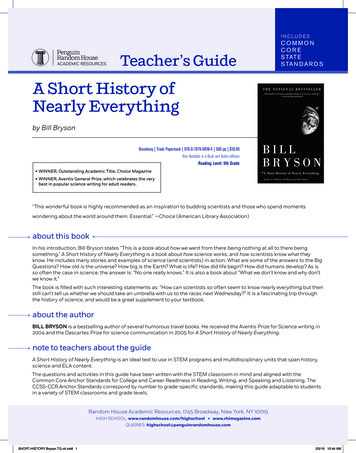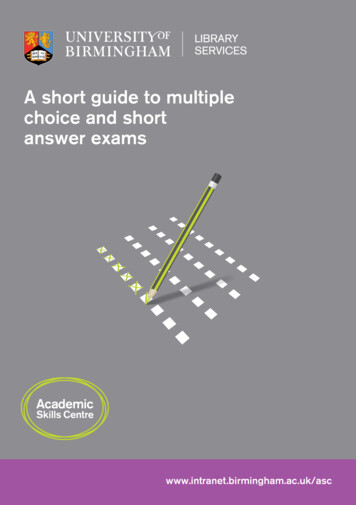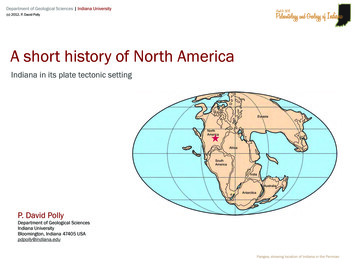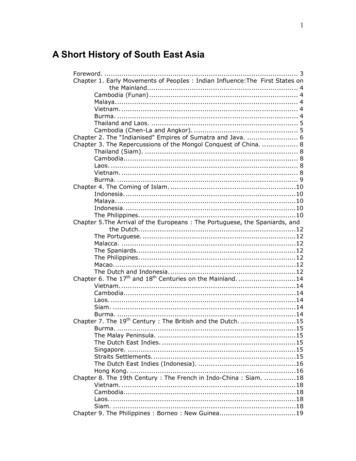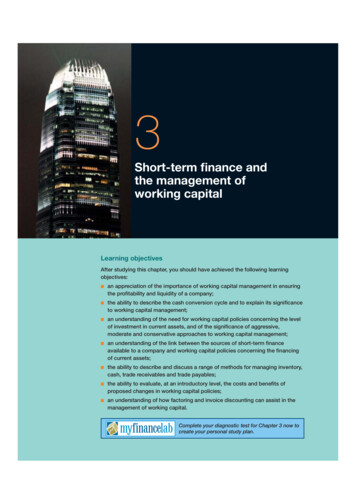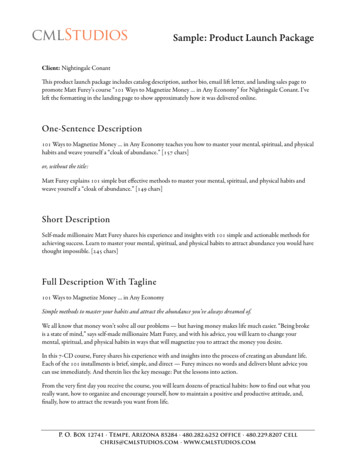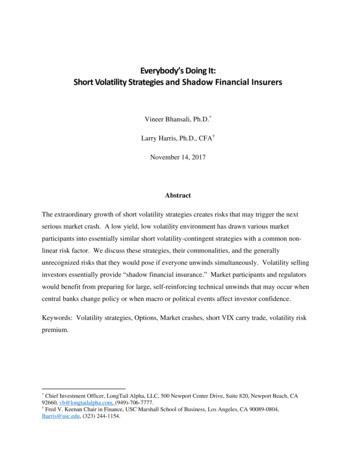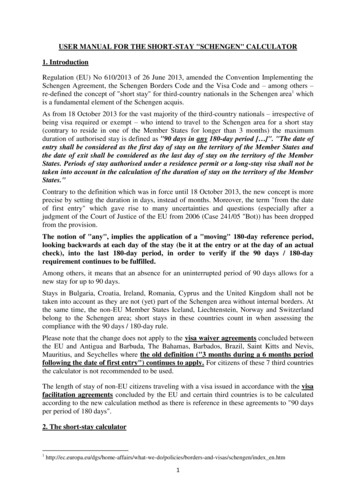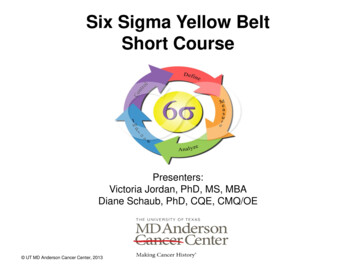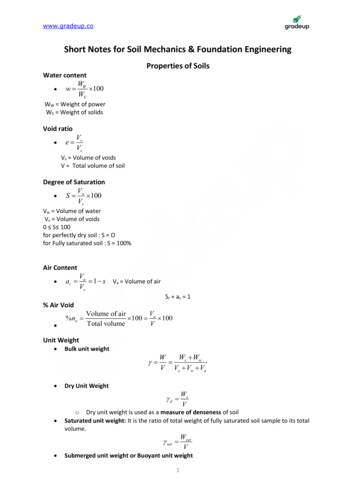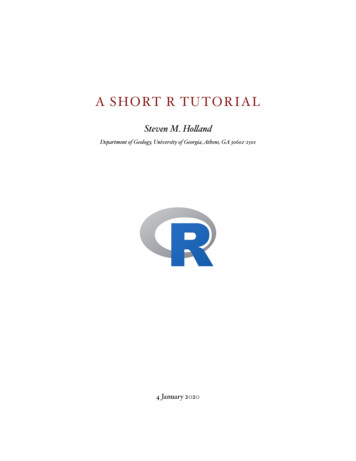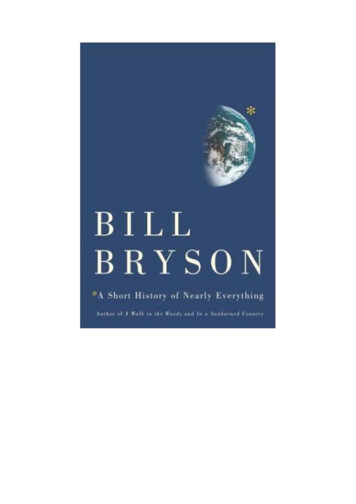
Transcription
AShort History ofNearly Everything
Copyright 2003 by Bill BrysonAll rights reserved under Internationaland Pan-American Copyright Conventions.Published in the United States of America byandom House Large Print in association withBroadway Books, New York and simultaneouslyin Canada by Random House ofCanada Limited, Toronto.Distributed by Random House, Inc., New York.The Library of Congress has established aCataloging-in-Publication record for this title.0-375-43200-0
ACKNOWLEDGMENTSAs I sit here, in early 2003, I have before me several pages of manuscript bearing majesticallyencouraging and tactful notes from Ian Tattersal of the American Museum of Natural Historypointing out, inter alia, that Perigueux is not a wineproducing region, that it is inventive but atouch unorthodox of me to italicize taxonomic divisions above the level of genus and species,that I have persistently misspelled Olorgesaille, a place that I recently visited, and so on insimilar vein through two chapters of text covering his area of expertise, early humans.Goodness knows how many other inky embarrassments may lurk in these pages yet, but itis thanks to Dr. Tattersall and all of those whom I am about to mention that there aren't manyhundreds more. I cannot begin to thank adequately those who helped me in the preparation ofthis book. I am especially indebted to the following, who were uniformly generous and kindlyand showed the most heroic reserves of patience in answering one simple, endlessly repeatedquestion: "I'm sorry, but can you explain that again?"In the United States: Ian Tattersall of the American Museum of Natural History in NewYork; John Thorstensen, Mary K. Hudson, and David Blanchflower of Dartmouth College inHanover, New Hampshire; Dr. William Abdu and Dr. Bryan Marsh of Dartmouth-HitchcockMedical Center in Lebanon, New Hampshire; Ray Anderson and Brian Witzke of the IowaDepartment of Natural Resources, Iowa city; Mike Voorhies of the University of Nebraskaand Ashfall Fossil Beds State Park near Orchard, Nebraska; Chuck Offenburger of BuenaVista University, Storm Lake, Iowa; Ken Rancourt, director of research, Mount WashingtonObservatory, Gorham, New Hampshire; Paul Doss, geologist of Yellowstone National Park,and his wife, Heidi, also of the National Park; Frank Asara of the University of California atBerkeley; Oliver Payne and Lynn Addison of the National Geographic Society; James O.Farlow, IndianaPurdue University; Roger L. Larson, professor of marine geophysics,University of Rhode Island; Jeff Guinn of the Fort Worth Star-Telegram newspaper; Jerry Kasten of Dallas, Texas; and the staff of the Iowa Historical Society in DesMoines.In England: David Caplin of Imperial College, London; Richard Fortey, Les Ellis, and KathyWay of the Natural History Museum; Martin Raff of University College, London; RosalindHarding of the Institute of Biological Anthropology in Oxford; Dr. Laurence Smaje, formerlyof the Wellcome Institute; and Keith Blackmore of The Times.In Australia: the Reverend Robert Evans of Hazelbrook, New South Wales; Alan Thorneand Victoria Bennett of the Australian National University in Canberra; Louise Burke andJohn Hawley of Canberra; Anne Milne of the Sydney Morning Herald; Ian Nowak, formerlyof the Geological Society of Western Australia; Thomas H. Rich of Museum Victoria; TimFlannery, director of the South Australian Museum in Adelaide; and the very helpful staff ofthe State Library of New South Wales in Sydney.And elsewhere: Sue Superville, information center manager at the Museum of New Zealandin Wellington, and Dr. Emma Mbua, Dr. Koen Maes, and Jillani Ngalla of the Kenya NationalMuseum in Nairobi.I am also deeply and variously indebted to Patrick Janson-Smith, Gerald Howard, MarianneVelmans, Alison Tulett, Larry Finlay, Steve Rubin, Jed Mattes, Carol Heaton, Charles Elliott,
David Bryson, Felicity Bryson, Dan McLean, Nick Southern, Patrick Gallagher, LarryAshmead, and the staff of the peerless and ever-cheery Howe Library in Hanover, NewHampshire.Above all, and as always, my profoundest thanks to my dear wife, Cynthia.
CONTENTSACKNOWLEDGMENTSINTRODUCTIONPART I123LOST IN THE COSMOSHow to Build a UniverseWelcome to the Solar SystemThe Reverend Evans's UniversePART II4567THE SIZE OF THE EARTHThe Measure of ThingsThe Stone-BreakersScience Red in Tooth and ClawElemental MattersPART III89101112ANEW AGE DAWNSEinstein's UniverseThe Mighty AtomGetting the Lead OutMuster Mark's QuarksThe Earth MovesPART IV131415DANGEROUS PLANETBang!The Fire BelowDangerous BeautyPART V1617181920212223242526LIFE ITSELFLonely PlanetInto the TroposphereThe Bounding MainThe Rise of LifeSmall WorldLife Goes OnGood-bye to All ThatThe Richness of BeingCellsDarwin's Singular NotionThe Stuff of Life
PART VITHE ROAD TO US27Ice Time28The Mysterious Biped29The Restless Ape30Good-byeNOTESBIBLIOGRAPHYINDEX
The physicist Leo Szilard once announced to his friend Hans Bethethat he was thinking of keeping a diary: "I don't intend to publish. Iam merely going to record the facts for the information of God.""Don't you think God knows the facts?" Bethe asked."Yes," said Szilard."He knows the facts, but He does not know this version of the facts."-Hans Christian von Baeyer,Taming the Atom
INTRODUCTIONWelcome. And congratulations. I am delighted that you could make it. Getting here wasn'teasy, I know. In fact, I suspect it was a little tougher than you realize.To begin with, for you to be here now trillions of drifting atoms had somehow to assemblein an intricate and intriguingly obliging manner to create you. It's an arrangement sospecialized and particular that it has never been tried before and will only exist this once. Forthe next many years (we hope) these tiny particles will uncomplainingly engage in all thebillions of deft, cooperative efforts necessary to keep you intact and let you experience thesupremely agreeable but generally underappreciated state known as existence.Why atoms take this trouble is a bit of a puzzle. Being you is not a gratifying experience atthe atomic level. For all their devoted attention, your atoms don't actually care about youindeed, don't even know that you are there. They don't even know that they are there. They aremindless particles, after all, and not even themselves alive. (It is a slightly arresting notionthat if you were to pick yourself apart with tweezers, one atom at a time, you would produce amound of fine atomic dust, none of which had ever been alive but all of which had once beenyou.) Yet somehow for the period of your existence they will answer to a single overarchingimpulse: to keep you you.The bad news is that atoms are fickle and their time of devotion is fleeting-fleeting indeed.Even a long human life adds up to only about 650,000 hours. And when that modestmilestone flashes past, or at some other point thereabouts, for reasons unknown your atomswill shut you down, silently disassemble, and go off to be other things. And that's it for you.Still, you may rejoice that it happens at all. Generally speaking in the universe it doesn't, sofar as we can tell. This is decidedly odd because the atoms that so liberally and congeniallyflock together to form living things on Earth are exactly the same atoms that decline to do itelsewhere. Whatever else it may be, at the level of chemistry life is curiously mundane:carbon, hydrogen, oxygen, and nitrogen, a little calcium, a dash of sulfur, a light dusting ofother very ordinary elements-nothing you wouldn't find in any ordinary drugstore-and that'sall you need. The only thing special about the atoms that make you is that they make you.That is of course the miracle of life.Whether or not atoms make life in other corners of the universe, they make plenty else;indeed, they make everything else. Without them there would be no water or air or rocks, nostars and planets, no distant gassy clouds or swirling nebulae or any of the other things thatmake the universe so usefully material. Atoms are so numerous and necessary that we easilyoverlook that they needn't actually exist at all. There is no law that requires the universe to fillitself with small particles of matter or to produce light and gravity and the other physicalproperties on which our existence hinges. There needn't actually be a universe at all. For thelongest time there wasn't. There were no atoms and no universe for them to float about in.There was nothing-nothing at all anywhere.So thank goodness for atoms. But the fact that you have atoms and that they assemble insuch a willing manner is only part of what got you here. To be here now, alive in the twentyfirst century and smart enough to know it, you also had to be the beneficiary of anextraordinary string of biological good fortune. Survival on Earth is a surprisingly trickybusiness. Of the billions and billions of species of living thing that have existed since thedawn of time, most-99.99 percent-are no longer around. Life on Earth, you see, is not only
brief but dismayingly tenuous. It is a curious feature of our existence that we come from aplanet that is very good at promoting life but even better at extinguishing it.The average species on Earth lasts for only about four million years, so if you wish to bearound for billions of years, you must be as fickle as the atoms that made you. You must beprepared to change everything about yourself-shape, size, color, species affiliation,everything-and to do so repeatedly. That's much easier said than done, because the process ofchange is random. To get from "protoplasmal primordial atomic globule" (as the Gilbert andSullivan song put it) to sentient upright modern human has required you to mutate new traitsover and over in a precisely timely manner for an exceedingly long while. So at variousperiods over the last 3.8 billion years you have abhorred oxygen and then doted on it, grownfins and limbs and jaunty sails, laid eggs, flicked the air with a forked tongue, been sleek,been furry, lived underground, lived in trees, been as big as a deer and as small as a mouse,and a million things more. The tiniest deviation from any of these evolutionary shifts, and youmight now be licking algae from cave walls or lolling walrus-like on some stony shore ordisgorging air through a blowhole in the top of your head before diving sixty feet for amouthful of delicious sandworms.Not only have you been lucky enough to be attached since time immemorial to a favoredevolutionary line, but you have also been extremely-make that miraculously-fortunate in yourpersonal ancestry. Consider the fact that for 3.8 billion years, a period of time older than theEarth's mountains and rivers and oceans, every one of your forebears on both sides has beenattractive enough to find a mate, healthy enough to reproduce, and sufficiently blessed by fateand circumstances to live long enough to do so. Not one of your pertinent ancestors wassquashed, devoured, drowned, starved, stranded, stuck fast, untimely wounded, or otherwisedeflected from its life's quest of delivering a tiny charge of genetic material to the rightpartner at the right moment in order to perpetuate the only possible sequence of hereditarycombinations that could result-eventually, astoundingly, and all too briefly-in you.This is a book about how it happened-in particular how we went from there being nothing atall to there being something, and then how a little of that something turned into us, and alsosome of what happened in between and since. That's a great deal to cover, of course, which iswhy the book is called A Short History of Nearly Everything, even though it isn't really. Itcouldn't be. But with luck by the time we finish it will feel as if it is.My own starting point, for what it's worth, was an illustrated science book that I had as aclassroom text when I was in fourth or fifth grade. The book was a standard-issue 1950sschoolbookbattered, unloved, grimly hefty-but near the front it had an illustration that justcaptivated me: a cutaway diagram showing the Earth's interior as it would look if you cut intothe planet with a large knife and carefully withdrew a wedge representing about a quarter ofits bulk.It's hard to believe that there was ever a time when I had not seen such an illustrationbefore, but evidently I had not for I clearly remember being transfixed. I suspect, in honesty,my initial interest was based on a private image of streams of unsuspecting eastboundmotorists in the American plains states plunging over the edge of a sudden 4,000-mile-highcliff running between Central America and the North Pole, but gradually my attention did turnin a more scholarly manner to the scientific import of the drawing and the realization that theEarth consisted of discrete layers, ending in the center with a glowing sphere of iron andnickel, which was as hot as the surface of the Sun, according to the caption, and I rememberthinking with real wonder: "How do they know that?"I didn't doubt the correctness of the information for an instant-I still tend to trust thepronouncements of scientists in the way I trust those of surgeons, plumbers, and otherpossessors of arcane and privileged information-but I couldn't for the life of me conceive how
any human mind could work out what spaces thousands of miles below us, that no eye hadever seen and no X ray could penetrate, could look like and be made of. To me that was just amiracle. That has been my position with science ever since.Excited, I took the book home that night and opened it before dinner-an action that I expectprompted my mother to feel my forehead and ask if I was all right-and, starting with the firstpage, I read.And here's the thing. It wasn't exciting at all. It wasn't actually altogether comprehensible.Above all, it didn't answer any of the questions that the illustration stirred up in a normalinquiring mind: How did we end up with a Sun in the middle of our planet? And if it isburning away down there, why isn't the ground under our feet hot to the touch? And why isn'tthe rest of the interior melting-or is it? And when the core at last burns itself out, will some ofthe Earth slump into the void, leaving a giant sinkhole on the surface? And how do you knowthis? How did you figure it out?But the author was strangely silent on such details-indeed, silent on everything butanticlines, synclines, axial faults, and the like. It was as if he wanted to keep the good stuffsecret by making all of it soberly unfathomable. As the years passed, I began to suspect thatthis was not altogether a private impulse. There seemed to be a mystifying universalconspiracy among textbook authors to make certain the material they dealt with never strayedtoo near the realm of the mildly interesting and was always at least a longdistance phone callfrom the frankly interesting.I now know that there is a happy abundance of science writers who pen the most lucid andthrilling prose-Timothy Ferris, Richard Fortey, and Tim Flannery are three that jump out froma single station of the alphabet (and that's not even to mention the late but godlike RichardFeynman)-but sadly none of them wrote any textbook I ever used. All mine were written bymen (it was always men) who held the interesting notion that everything became clear whenexpressed as a formula and the amusingly deluded belief that the children of America wouldappreciate having chapters end with a section of questions they could mull over in their owntime. So I grew up convinced that science was supremely dull, but suspecting that it needn'tbe, and not really thinking about it at all if I could help it. This, too, became my position for along time.Then much later-about four or five years ago-I was on a long flight across the Pacific,staring idly out the window at moonlit ocean, when it occurred to me with a certainuncomfortable forcefulness that I didn't know the first thing about the only planet I was evergoing to live on. I had no idea, for example, why the oceans were salty but the Great Lakesweren't. Didn't have the faintest idea. I didn't know if the oceans were growing more saltywith time or less, and whether ocean salinity levels was something I should be concernedabout or not. (I am very pleased to tell you that until the late 1970s scientists didn't know theanswers to these questions either. They just didn't talk about it very audibly.)And ocean salinity of course represented only the merest sliver of my ignorance. I didn'tknow what a proton was, or a protein, didn't know a quark from a quasar, didn't understandhow geologists could look at a layer of rock on a canyon wall and tell you how old it was,didn't know anything really. I became gripped by a quiet, unwonted urge to know a littleabout these matters and to understand how people figured them out. That to me remained thegreatest of all amazements-how scientists work things out. How does anybody know howmuch the Earth weighs or how old its rocks are or what really is way down there in thecenter? How can they know how and when the universe started and what it was like when itdid? How do they know what goes on inside an atom? And how, come to that-or perhapsabove all-can scientists so often seem to know nearly everything but then still can't predict anearthquake or even tell us whether we should take an umbrella with us to the races nextWednesday?
So I decided that I would devote a portion of my life-three years, as it now turns out-toreading books and journals and finding saintly, patient experts prepared to answer a lot ofoutstandingly dumb questions. The idea was to see if it isn't possible to understand andappreciate-marvel at, enjoy even-the wonder and accomplishments of science at a level thatisn't too technical or demanding, but isn't entirely superficial either.That was my idea and my hope, and that is what the book that follows is intended to be.Anyway, we have a great deal of ground to cover and much less than 650,000 hours in whichto do it, so let's begin.
PART ILOST IN THE COSMOSThey’re all in the same plane.They’re all going around in thesame direction. . . . It’s perfect,you know. It’s gorgeous. It’salmost uncanny.-Astronomer Geoffrey Marcydescribing the solar system
1 HOW TO BUILD A UNIVERSENO MATTER HOW hard you try you will never be able to grasp just how tiny, how spatiallyunassuming, is a proton. It is just way too small.A proton is an infinitesimal part of an atom, which is itself of course an insubstantial thing.Protons are so small that a little dib of ink like the dot on this i can hold something in theregion of 500,000,000,000 of them, rather more than the number of seconds contained in halfa million years. So protons are exceedingly microscopic, to say the very least.Now imagine if you can (and of course you can’t) shrinking one of those protons down to abillionth of its normal size into a space so small that it would make a proton look enormous.Now pack into that tiny, tiny space about an ounce of matter. Excellent. You are ready to starta universe.I’m assuming of course that you wish to build an inflationary universe. If you’d preferinstead to build a more old-fashioned, standard Big Bang universe, you’ll need additionalmaterials. In fact, you will need to gather up everything there is every last mote and particle ofmatter between here and the edge of creation and squeeze it into a spot so infinitesimallycompact that it has no dimensions at all. It is known as a singularity.In either case, get ready for a really big bang. Naturally, you will wish to retire to a safeplace to observe the spectacle. Unfortunately, there is nowhere to retire to because outside thesingularity there is no where. When the universe begins to expand, it won’t be spreading outto fill a larger emptiness. The only space that exists is the space it creates as it goes.It is natural but wrong to visualize the singularity as a kind of pregnant dot hanging in adark, boundless void. But there is no space, no darkness. The singularity has no “around”around it. There is no space for it to occupy, no place for it to be. We can’t even ask how longit has been there—whether it has just lately popped into being, like a good idea, or whether ithas been there forever, quietly awaiting the right moment. Time doesn’t exist. There is no pastfor it to emerge from.And so, from nothing, our universe begins.In a single blinding pulse, a moment of glory much too swift and expansive for any form ofwords, the singularity assumes heavenly dimensions, space beyond conception. In the firstlively second (a second that many cosmologists will devote careers to shaving into ever-finerwafers) is produced gravity and the other forces that govern physics. In less than a minute theuniverse is a million billion miles across and growing fast. There is a lot of heat now, tenbillion degrees of it, enough to begin the nuclear reactions that create the lighter elements—principally hydrogen and helium, with a dash (about one atom in a hundred million) oflithium. In three minutes, 98 percent of all the matter there is or will ever be has beenproduced. We have a universe. It is a place of the most wondrous and gratifying possibility,and beautiful, too. And it was all done in about the time it takes to make a sandwich.
When this moment happened is a matter of some debate. Cosmologists have long arguedover whether the moment of creation was 10 billion years ago or twice that or something inbetween. The consensus seems to be heading for a figure of about 13.7 billion years, but thesethings are notoriously difficult to measure, as we shall see further on. All that can really besaid is that at some indeterminate point in the very distant past, for reasons unknown, therecame the moment known to science as t 0. We were on our way.There is of course a great deal we don’t know, and much of what we think we know wehaven’t known, or thought we’ve known, for long. Even the notion of the Big Bang is quite arecent one. The idea had been kicking around since the 1920s, when Georges Lemaître, aBelgian priest-scholar, first tentatively proposed it, but it didn’t really become an activenotion in cosmology until the mid-1960s when two young radio astronomers made anextraordinary and inadvertent discovery.Their names were Arno Penzias and Robert Wilson. In 1965, they were trying to make useof a large communications antenna owned by Bell Laboratories at Holmdel, New Jersey, butthey were troubled by a persistent background noise—a steady, steamy hiss that made anyexperimental work impossible. The noise was unrelenting and unfocused. It came from everypoint in the sky, day and night, through every season. For a year the young astronomers dideverything they could think of to track down and eliminate the noise. They tested everyelectrical system. They rebuilt instruments, checked circuits, wiggled wires, dusted plugs.They climbed into the dish and placed duct tape over every seam and rivet. They climbedback into the dish with brooms and scrubbing brushes and carefully swept it clean of whatthey referred to in a later paper as “white dielectric material,” or what is known morecommonly as bird shit. Nothing they tried worked.Unknown to them, just thirty miles away at Princeton University, a team of scientists led byRobert Dicke was working on how to find the very thing they were trying so diligently to getrid of. The Princeton researchers were pursuing an idea that had been suggested in the 1940sby the Russian-born astrophysicist George Gamow that if you looked deep enough into spaceyou should find some cosmic background radiation left over from the Big Bang. Gamowcalculated that by the time it crossed the vastness of the cosmos, the radiation would reachEarth in the form of microwaves. In a more recent paper he had even suggested an instrumentthat might do the job: the Bell antenna at Holmdel. Unfortunately, neither Penzias andWilson, nor any of the Princeton team, had read Gamow’s paper.The noise that Penzias and Wilson were hearing was, of course, the noise that Gamow hadpostulated. They had found the edge of the universe, or at least the visible part of it, 90 billiontrillion miles away. They were “seeing” the first photons—the most ancient light in theuniverse—though time and distance had converted them to microwaves, just as Gamow hadpredicted. In his book The Inflationary Universe , Alan Guth provides an analogy that helps toput this finding in perspective. If you think of peering into the depths of the universe as likelooking down from the hundredth floor of the Empire State Building (with the hundredth floorrepresenting now and street level representing the moment of the Big Bang), at the time ofWilson and Penzias’s discovery the most distant galaxies anyone had ever detected were onabout the sixtieth floor, and the most distant things—quasars—were on about the twentieth.Penzias and Wilson’s finding pushed our acquaintance with the visible universe to within halfan inch of the sidewalk.Still unaware of what caused the noise, Wilson and Penzias phoned Dicke at Princeton anddescribed their problem to him in the hope that he might suggest a solution. Dicke realized at
once what the two young men had found. “Well, boys, we’ve just been scooped,” he told hiscolleagues as he hung up the phone.Soon afterward the Astrophysical Journal published two articles: one by Penzias andWilson describing their experience with the hiss, the other by Dicke’s team explaining itsnature. Although Penzias and Wilson had not been looking for cosmic background radiation,didn’t know what it was when they had found it, and hadn’t described or interpreted itscharacter in any paper, they received the 1978 Nobel Prize in physics. The Princetonresearchers got only sympathy. According to Dennis Overbye in Lonely Hearts of the Cosmos, neither Penzias nor Wilson altogether understood the significance of what they had founduntil they read about it in the New York Times .Incidentally, disturbance from cosmic background radiation is something we have allexperienced. Tune your television to any channel it doesn’t receive, and about 1 percent of thedancing static you see is accounted for by this ancient remnant of the Big Bang. The next timeyou complain that there is nothing on, remember that you can always watch the birth of theuniverse.Although everyone calls it the Big Bang, many books caution us not to think of it as anexplosion in the conventional sense. It was, rather, a vast, sudden expansion on a whoppingscale. So what caused it?One notion is that perhaps the singularity was the relic of an earlier, collapsed universe—that we’re just one of an eternal cycle of expanding and collapsing universes, like the bladderon an oxygen machine. Others attribute the Big Bang to what they call “a false vacuum” or “ascalar field” or “vacuum energy”—some quality or thing, at any rate, that introduced ameasure of instability into the nothingness that was. It seems impossible that you could getsomething from nothing, but the fact that once there was nothing and now there is a universeis evident proof that you can. It may be that our universe is merely part of many largeruniverses, some in different dimensions, and that Big Bangs are going on all the time all overthe place. Or it may be that space and time had some other forms altogether before the BigBang—forms too alien for us to imagine—and that the Big Bang represents some sort oftransition phase, where the universe went from a form we can’t understand to one we almostcan. “These are very close to religious questions,” Dr. Andrei Linde, a cosmologist atStanford, told the New York Times in 2001.The Big Bang theory isn’t about the bang itself but about what happened after the bang.Not long after, mind you. By doing a lot of math and watching carefully what goes on inparticle accelerators, scientists believe they can look back to 10-43seconds after the moment ofcreation, when the universe was still so small that you would have needed a microscope tofind it. We mustn’t swoon over every extraordinary number that comes before us, but it isperhaps worth latching on to one from time to time just to be reminded of their ungraspableand amazing breadth. Thus 10-43is 0.0000000000000000000000000000000000000000001, orone 10 million trillion trillion trillionths of a second.**A word on scientific notation: Since very large numbers are cumbersome to write and nearly impossible to read, scientistsuse a shorthand involving powers (or multiples) of ten in which, for instance, 10,000,000,000 is written 1010 and 6,500,000becomes 6.5 x 106. The principle is based very simply on multiples of ten: 10 x 10 (or 100) becomes 102; 10 x 10 x 10 (or1,000) is 103; and so on, obviously and indefinitely. The little superscript number signifies the number of zeroes followingthe larger principal number. Negative notations provide latter in print (especially essentially a mirror image, with thesuperscript number indicating the number of spaces to the right of the decimal point (so 10-4 means 0.0001). Though I salutethe principle, it remains an amazement to me that anyone seeing "1.4 x 109 km3’ would see at once that that signifies 1.4
Most of what we know, or believe we know, about the early moments of the universe isthanks to an idea called inflation theory first propounded in 1979 by a junior particlephysicist, then at Stanford, now at MIT, named Alan Guth. He was thirty-two years old and,by his own admission, had never done anything much before. He would probably never havehad his great theory except that he happened to attend a lecture on the Big Bang given bynone other than Robert Dicke. The lecture inspired Guth to take an interest in cosmology, andin particular in the birth of the universe.The eventual result was the inflation theory, which holds that a fraction of a moment afterthe dawn of creation, the universe underwent a sudden dramatic expansion. It inflated—i
encouraging and tactful notes from Ian Tattersal of the American Museum of Natural History pointing out, inter alia, that Perigueux is not a wineproducing region, that it is inventive but a . and all too briefly-in you. A Short History of Nearly Everything.File Size: 1MBPage Count: 298
